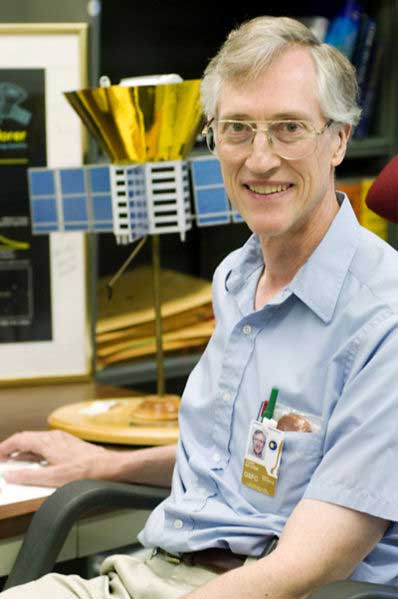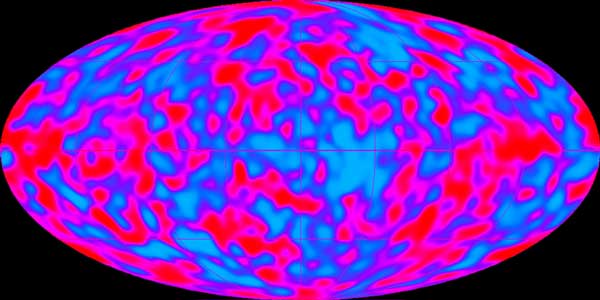.
John Cromwell Mather

John C. Mather at NASA
John Cromwell Mather (b. 1946 in Roanoke, Virginia), is an American astrophysicist and cosmologist.
Mather is a senior astrophysicist at the U.S. space agency's (NASA) Goddard Space Flight Center in Maryland and adjunct professor of physics at the University of Maryland, College Park. He was awarded the 2006 Nobel Prize in Physics, shared with George F. Smoot for "their discovery of the black body form and anisotropy of the cosmic microwave background radiation". This work helped cement the big-bang theory of the universe using the COBE (Cosmic Background Explorer) satellite. According to the Nobel Prize committee, "the COBE-project can also be regarded as the starting point for cosmology as a precision science". [1]
Biography
Education and initial research
- 1968 B.A. (Physics), Swarthmore College
- 1974 Ph.D. (Physics), University of California, Berkeley
Participation in COBE
The success of COBE was the outcome of prodigious team work involving more than 1,000 researchers, engineers and other participants. John Mather coordinated the entire process and also had primary responsibility for the experiment that revealed the blackbody form of the microwave background radiation measured by COBE. George Smoot had main responsibility for measuring the small variations in the temperature of the radiation[2].
He chronicled his team's work in a book for the general public. The book, The Very First Light: The True Inside Story of the Scientific Journey Back to the Dawn of the Universe [3] was co-written with John Boslough, and published in 1996.

Cosmic microwave background temperature data were extracted from the released FITS files and then combined into two linear combinations. The first is a weighted sum of the 53 and 90 GHz channels which gives the highest signal-to-noise ratio for cosmic temperature variations but includes the Milky Way Galaxy as well. In the second linear combination, a multiple of the 31 GHz map is subtracted from a weighted sum of the 53 plus 90 GHz channels to give a "reduced map" that gives zero response to the observed Galaxy, zero response to free-free emission, but full response to variations in the cosmic temperature. These maps have been smoothed with a 7 degree beam, giving an effective angular resolution of 10 degrees. An all-sky image in Galactic coordinates is plotted using the equal-area Mollweide projection. The plane of the Milky Way Galaxy is horizontal across the middle of each picture. Sagittarius is in the center of the map, Orion is to the right and Cygnus is to the left.
The following image just shows the reduced map (i.e., both the dipole and Galactic emission subtracted). The cosmic microwave background fluctuations are extremely faint, only one part in 100,000 compared to the 2.73 degree Kelvin average temperature of the radiation field. The cosmic microwave background radiation is a remnant of the Big Bang and the fluctuations are the imprint of density contrast in the early universe. The density ripples are believed to have given rise to the structures that populate the universe today: clusters of galaxies and vast regions devoid of galaxies."
Source
Awards
- Open Scholarship (honorary), Swarthmore, 1964-68
- William Lowell Putnam Mathematical Competition, 1967, 30th place nationwide
- NSF Fellowship and honorary Woodrow Wilson Fellowship 1968-70
- Hertz Foundation Fellowship, 1970-74
- John C. Lindsay Memorial Award (NASA-GSFC), 1990
- Rotary National Space Achievement Award, 1991
- National Air and Space Museum Trophy, 1991
- Aviation Week and Space Technology Laurels, 1992, for Space/Missiles
- Discover Magazine Technology Award finalist, 1993
- American Institute of Aeronautics and Astronautics Space Science Award, 1993
- Dannie Heineman Prize for Astrophysics, American Astronomical Society and American
- Institute of Physics, 1993 (presented Jan. 1994)
- Goddard Fellow, 1994, GSFC
- Honorary Doctor of Science Degree, Swarthmore College, 1994
- John Scott Award, City of Philadelphia, 1995
- Rumford Prize, American Academy of Arts and Sciences, 1996
- Fellow, American Physical Society, 1996
- Hall of Fame, Aviation Week and Space Technology, 1997
- Member, National Academy of Sciences, 1997
- Marc Aaronson Memorial Prize, 1998
- Member, American Academy of Arts and Sciences, 1998
- Benjamin Franklin Medal in Physics, Franklin Institute, 1999
- George W. Goddard Award, Society of Photo-Optical Instrumentation Engineers, 2005
- Cosmology Prize, with COBE Team, Peter Gruber Foundation, 2006
- Nobel Prize in Physics, 2006
Links
- Interview with John Mather from the SPIE Newsroom
- Short biography at the Goddard Space Flight Center
- Berkeley lab article
References
- ^ Information for the public (PDF). The Royal Swedish Academy of Sciences (2006-10-03). Retrieved on 2006-10-05.
- ^ Press release: Pictures of a newborn Universe
- ^ The Very First Light: The True Inside Story of the Scientific Journey Back to the Dawn of the Universe, by John C. Mather and John Boslough, Basic Books edition (November 1998) ISBN 046501576X
Retrieved from "http://en.wikipedia.org/"
All text is available under the terms of the GNU Free Documentation License

